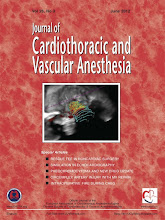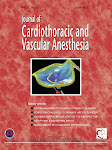Madhav Swaminathan, MD
Section Editors
Systolic Anterior Motion After Mitral Valve Repair and a Systolic Anterior Motion Tolerance Test
Gerard R. Manecke, MD, Liem C. Nguyen, MD, Adam D. Tibble, MD, Eugene Golts, MD, and Dalia Banks, MD
From the Department of Anesthesiology and Division of Cardiothoracic Surgery, University of California
San Diego Medical Center, San Diego, CA
Address reprint requests to Gerard R. Manecke, MD, Department of Anesthesiology, University of California San Diego, 200 West Arbor Drive, San Diego, CA 92103.
E-mail: gmanecke@ucsd.edu © 2010 Elsevier Inc. All rights reserved. 1053-0770/2405-0026$36.00/0 doi :10.1053/j.jvca.2010.07.021.
Key words: mitral valve repair, systolic anterior motion
A 62-YEAR-OLD MAN with an unremarkable medical history presented for mitral valve repair and single-vessel coronary artery bypass. He had experienced a 2-month period of increasing dyspnea on exertion, and his cardiologist noted a IV/VI systolic murmur. His lifestyle was sedentary; he performed basic chores and occasional climbing of a flight of stairs. He did not partake in regular exercise. A preoperative transthoracic echocardiogram showed moderate/severe mitral regurgitation (MR), thickened mitral leaflets, prolapse of the posterior mitral leaflet, a mildly dilated left atrium, and normal left ventricular function. Cardiac catheterization revealed an 85% lesion in the distal left anterior descending artery.
Intraoperative monitoring included a radial arterial catheter, pulmonary artery catheter, and transesophageal echocardiography (TEE). Anesthetic induction (midazolam/fentanyl/relaxant) and maintenance (isoflurane in oxygen) were uneventful. The pre-cardiopulmonary bypass (CPB) transesophageal echocardiographic findings were in agreement with those of the preoperative transthoracic echocardiogram (Fig 1 and Video 1 ^[supplementary videos are available online^]). Representative pre-CPB hemodynamics were as follows: heart rate, 72 beats/min; blood pressure (BP), 110/70 mmHg; cardiac output (CO), 4.5 L/min; pulmonary artery pressure (PAP), 28/14 mmHg; and central venous pressure (CVP), 6 mmHg.
The surgical procedure, via a midline sternotomy, consisted of a coronary bypass graft to the left anterior descending artery using the left internal mammary artery and mitral valve repair. The repair involved resection of a large, redundant P2 segment and placement of an annuloplasty ring (28-mm Carpentier-Edwards Physio Ring; Edwards Lifesciences, Irvine, CA). The anterior leaflet did not appear particularly redundant upon surgical inspection, so it was not resected.
Separation from CPB was accomplished easily, without the use of vasoactive medications. TEE before decannulation revealed only trace MR, and hemodynamics were favorable (heart rate, 80 beats/min; BP, 110/70 mmHg; PAP, 28/14 mmHg; CO, 5.5 L/min; CVP, 6 mmHg). However, systolic anterior motion (SAM) of the mitral leaflets was noted, with dynamic obstruction of the left ventricular outflow tract (LVOT) and turbulent aortic flow (Fig 2 and Video 2). After discussion with the surgeon,a provocative test was performed. This was performed while the great vessels were still cannulated, with the goal of determining if his SAM would be tolerated should he become hypovolemic, tachycardic, and vasodilated postoperatively. For 15 minutes, ventricular pacing at 120 beats/min was instituted, and nitroglycerin, 200 µg/min, and dopamine, 7 µg/kg/min, were administered.The BP dropped to 80/50 mmHg but was then maintained, CO was maintained at >5 L/min, PAP rose to 42/24 mm Hg, and the CVP remained at 6 mmHg. TEE revealed some worsening of the MR (moderate), and the LVOT obstruction appeared to worsen slightly, with the appearance of a "double envelope" on continuous-wave Doppler of the LVOT (Video 2). The decision then was made to discontinue the dopamine, nitroglycerin, and pacing. No further surgery was performed on the mitral valve, and the remainder of the operation was uneventful. His postoperative period was likewise uneventful, and he was discharged on the 9th postoperative day with a prescription for daily β-blockade therapy.
Discussion
SAM is not uncommon after mitral valve repair, having been reported to occur in 8.4% of cases.1 Anatomic risk factors for its development include a short coaptation-septal distance (C-sept)2; low anterior leaflet:posterior leaflet length ratio2; large, redundant leaflets3; and septal hypertrophy.3 Hemodynamic risks include highly contractile state, hypovolemia, tachycardia, and low afterload. This patient presented with all the anatomic risks, including short C-sept (2.24 cm) and low anterior:posterior ratio (0.75) before repair.2
SAM after mitral valve repair often is well tolerated, and, when initially present, may resolve after mitral valve repair.1 Indeed, patients with SAM from other causes are often asymptomatic (and undiagnosed) until an inciting injury results in hypovolemia and a high catecholamine state.4
The question was not if SAM was present but rather how well the patient would tolerate it under "SAM-aggravating" conditions. In the authors' experience, when severe SAM occurs after mitral repair, it can result in "wide-open" MR, LVOT obstruction, very high PAP, and hypotension, necessitating a return to CPB. In such cases, it is obvious that the valve must either be rerepaired or replaced. This patient presented a "gray-zone" situation in which hemodynamics were favorable after CPB, but the presence of SAM was clear.
A potentially useful test that may help in determining if a patient is at postoperative risk for SAM has been described by Crescenzi et al.5 This group treats intraoperative SAM with conservative measures (intravascular volume expansion and discontinuation of inotropes) as well as more aggressive ones (β-blockade, increasing afterload by manual compression of the ascending aorta). These authors suggest surgical revision of the repair if conservative measures fail to result in the resolution of SAM.
In contrast, the test the present authors propose, the "SAM tolerance test," is designed to determine, given that SAM is present, how well it will be tolerated postoperatively if SAM-aggravating conditions (hypovolemia, vasodilatation, and high contractile state) develop. The patient's condition deteriorated somewhat with this test, but he did not suffer hemodynamic collapse, severe hypotension, or require reinstitution of CPB. The test was performed with the great vessels still cannulated and before heparin reversal in case a return to CPB became necessary. Considering his sedentary lifestyle and his ability to tolerate (with some struggle) the "SAM tolerance test," the authors believe this patient very likely will tolerate SAM should it persist postoperatively. The authors strongly recommend that such patients receive chronic β-blocker therapy and be advised to remain well-hydrated and to report deteriorating exercise tolerance to their cardiologist immediately.
Readers are encouraged to view the online videos (Videos 1 and 2) and share their thoughts on the potential utility of this test at the JCVA online blog site.


Appendix
Supplementary data
Supplementary data associated with this article can be found, in the online version, at doi :10.1053/j.jvca.2010.07.021.
References
1. Brown ML, Abel MD, Click RL, et al: Systolic anterior motion after mitral valve repair: Is surgical intervention necessary? J Thorac Cardiovasc Surg 133:136-143, 2007
2. Maslow AD, Regan MM, Haering JM, et al: Echocardiographic predictors of left ventricular outflow tract obstruction and systolic anterior motion of the mitral valve after mitral valve reconstruction for myxomatous valve disease. J Am Coll Cardiol 34:2096-2104, 1999
3. Tewari P, Basu R: Left ventricular outflow tract obstruction after mitral valve replacement.Anesth Analg 106:65-66, 2008
4. Luckner G, Margreiter J, Jochberger S, et al: Systolic anterior motion of the mitral valve with left ventricular outflow tract obstruction: Three cases of acute perioperative hypotension in noncardiac surgery. Anesth Analg 100:1594-1598, 2005
5. Crescenzi G, Landoni G, Zangrillo A, et al: Management and decision-making strategy for systolic anterior motion after mitral valve repair. J Thorac Cardiovasc Surg 137:320-325, 2009

